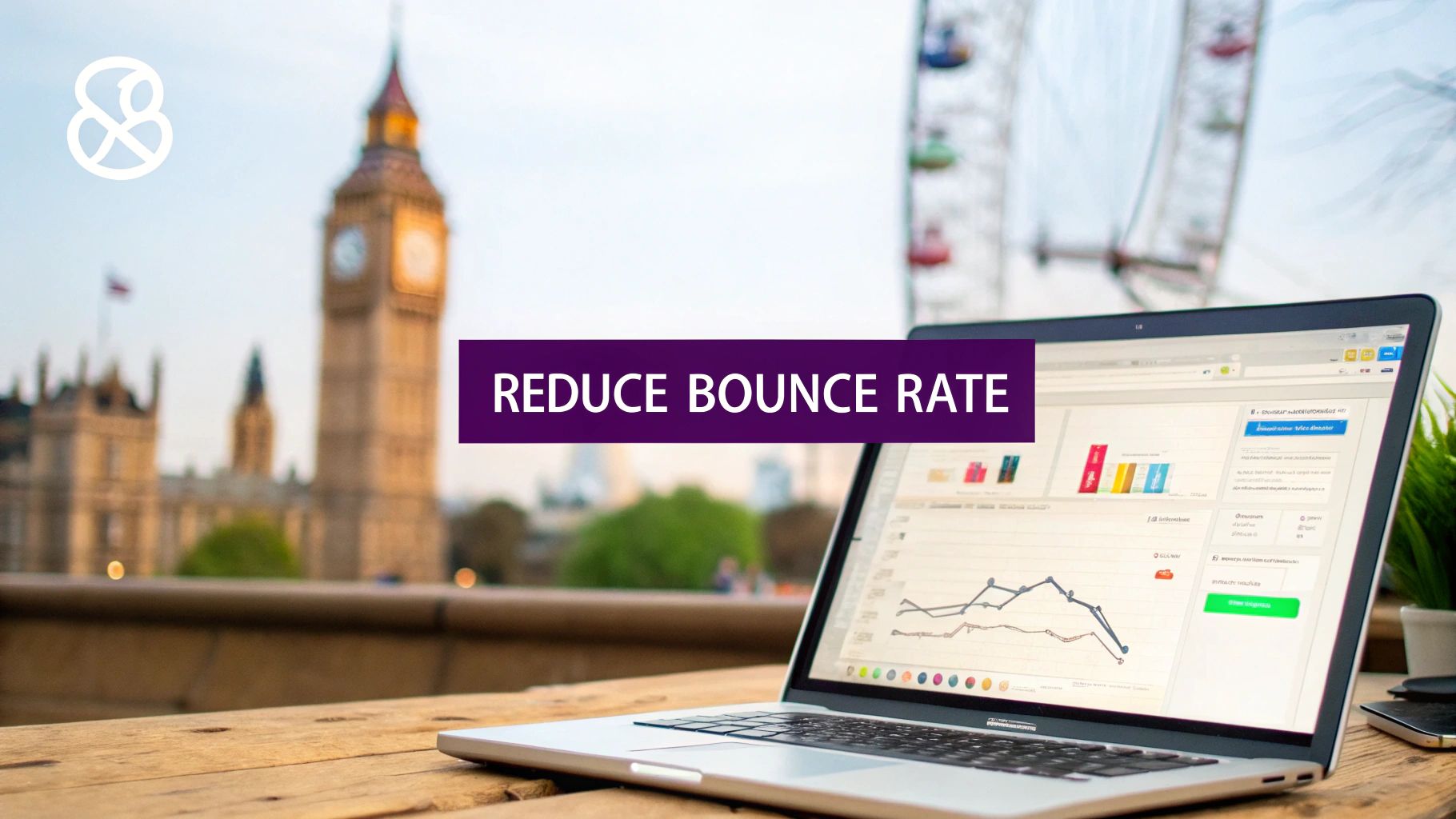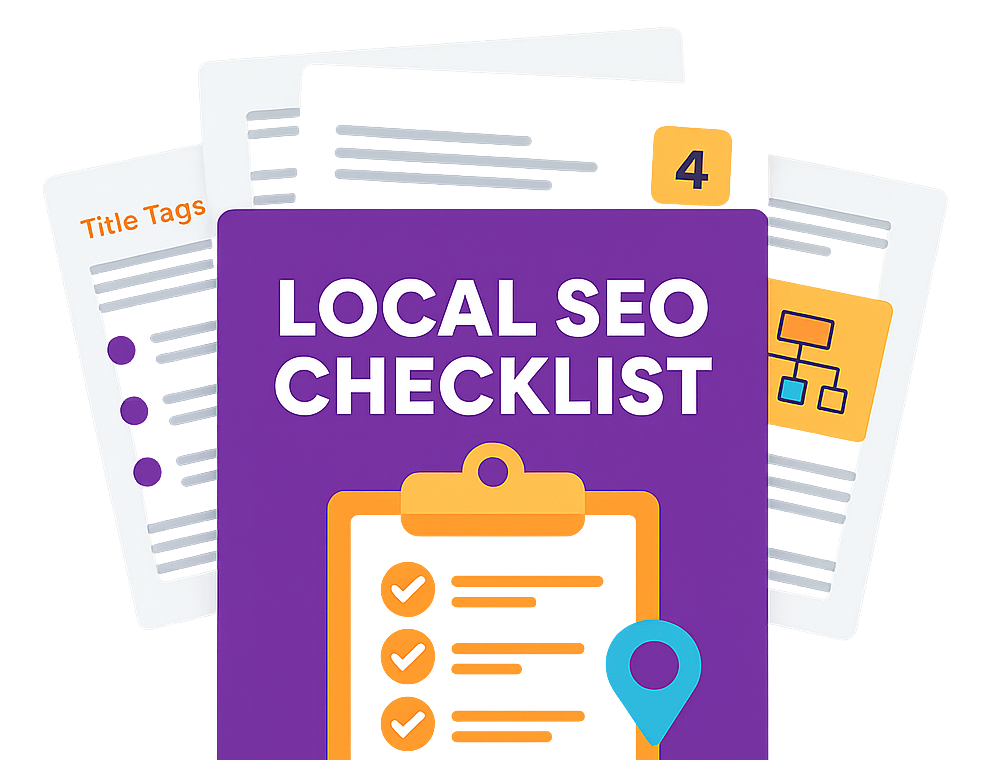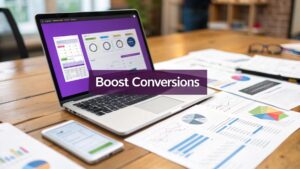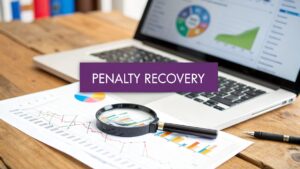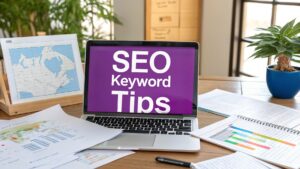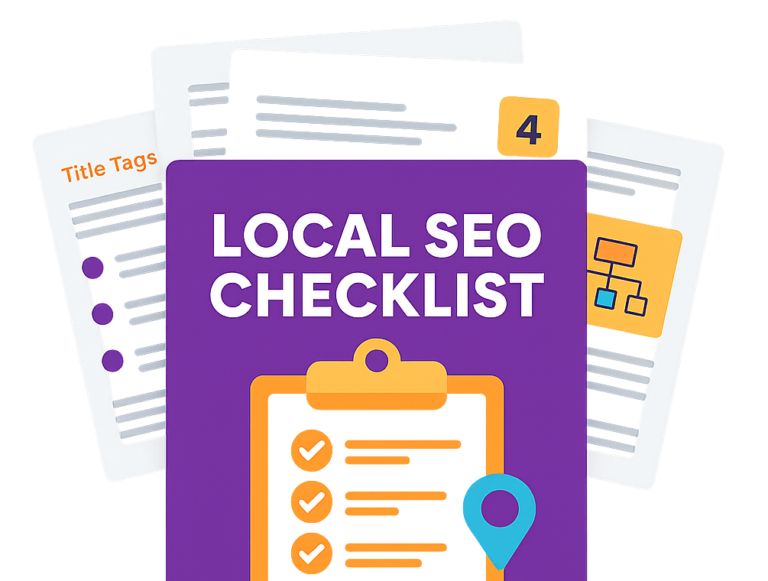To really get a handle on lowering your bounce rate, you first have to get inside your visitors' heads. What do they need? Once you know that, your job is to give it to them instantly. This isn't just one thing; it's a mix of lightning-fast page speeds, compelling content that actually matches what they searched for, and a clean, intuitive user experience—especially on mobile.
Understanding Bounce Rate And Why It Matters

Before you can start fixing things, you need to be crystal clear on what bounce rate actually is.
Put simply, a bounce happens when someone lands on a page of your website and then leaves without doing anything else. They don't click a link, fill out a form, or navigate to a second page. Your bounce rate is just the percentage of all your website visits that were single-page sessions.
But this metric is so much more than a number in Google Analytics; it's a direct reflection of user satisfaction. A high bounce rate is often a sign that your page missed the mark. Maybe it failed to meet their expectations, was painfully slow to load, or was just plain confusing to navigate. For any UK business, that translates directly into lost opportunities, whether it's a potential customer ditching a product page or a B2B lead clicking away from your services page.
What Is A Good Bounce Rate In The UK?
Defining a "good" bounce rate isn't as straightforward as you'd think, because it really depends on the industry and the type of page. A blog post designed to give a quick answer to a single question will naturally have a higher bounce rate than an e-commerce homepage, and that's okay.
That said, we can still set some general benchmarks to help you figure out where your site stands:
- 26% – 40% is generally considered excellent. You're doing a great job of engaging visitors.
- 41% – 55% is a healthy, average range for most websites.
- 56% – 70% is a bit higher than average but can be acceptable for content like blogs or news sites.
- Above 70% usually signals there's an issue somewhere that needs a closer look.
The key is context. A high bounce rate on your contact page might be perfectly fine—a visitor could have just grabbed your phone number and left. But a 75% bounce rate on one of your main service pages? That's a huge red flag.
The table below breaks down what you can typically expect from different traffic sources. This context is crucial for understanding whether your numbers are normal or a cause for concern.
Bounce Rate Benchmarks by Traffic Source in the UK
| Traffic Channel | Average Bounce Rate (%) | Visitor Intent |
|---|---|---|
| Organic Search | 40% – 60% | High, often looking for specific information |
| Paid Search | 30% – 50% | Very high, focused on a specific product/service |
| Direct Traffic | 15% – 35% | High, familiar with the brand |
| Referral Traffic | 35% – 55% | Varies, depends on the referring site's context |
| Social Media | 50% – 70% | Low, often browsing casually or for entertainment |
| Display Ads | 60% – 90% | Very low, often accidental clicks |
As you can see, someone clicking a display ad is far more likely to bounce than someone who typed your website address directly into their browser. Keep these benchmarks in mind when you're analysing your own data.
The Real Impact Of A High Bounce Rate
A high bounce rate isn't just about lost traffic; it has real, tangible consequences for your business. For one, it signals to search engines like Google that your content might not be a great match for what people are searching for. If visitors repeatedly 'pogo-stick'—clicking your link and then immediately returning to the search results—Google might start favouring competitors who provide a more engaging experience.
Here in the United Kingdom, we've seen some encouraging trends, particularly in e-commerce. Data shows that the average bounce rate for e-commerce sites dropped from around 55.1% in Q1 2023 to about 36.9% in Q1 2024. That's an impressive 18.23% decline in just one year, pointing to a big push towards better site design, faster load times, and more relevant content.
If you're ready for a deeper dive into the nuances of user engagement and the specific steps you can take to keep visitors on your site longer, have a look at our comprehensive guide on improving bounce rate.
Designing a User Experience That Captivates

Think of your website like a physical shop. If a customer walks in and the aisles are cluttered, the signs are confusing, and they can't find what they're looking for, they'll turn around and walk straight out. A confusing website works in exactly the same way, sending your bounce rate soaring.
A captivating user experience (UX) is your best tool for convincing visitors to stay, explore, and engage. It’s about making your site intuitive, accessible, and genuinely pleasant to use—a non-negotiable for lowering your bounce rate.
Simplify Your Website Navigation
If users can't find what they need in seconds, they’re gone. Overly complex menus or a confusing site structure are common culprits for a high bounce rate. The goal is clarity and simplicity.
Your main navigation menu should be concise and logical. Stick to clear, familiar labels like "Services," "About Us," and "Contact" rather than vague, creative terms that might confuse visitors. Every item in your menu should lead to a clear destination.
To sharpen up your site's structure, you can:
- Limit Menu Items: Aim for no more than seven main navigation items. Anything more can feel overwhelming.
- Use Breadcrumbs: These little navigation trails show users where they are on your site, making it easy to backtrack or explore related sections.
- Include a Search Bar: A prominent and effective search function is a must-have, especially for larger websites with a lot of content or products.
Embrace Mobile-First Design
With a huge slice of UK web traffic now coming from mobile devices, a clunky mobile experience is simply not an option. A website that isn't optimised for smaller screens—forcing users to pinch, zoom, and scroll endlessly—is guaranteed to have a high bounce rate.
Adopting a mobile-first approach means you design the experience for the smallest screen first, then scale it up for larger devices. This forces you to prioritise the most important content and features, resulting in a cleaner, more focused design across all platforms.
A truly effective website puts the user at the centre of every design decision. From intuitive navigation to mobile responsiveness, each element should work together to create a seamless journey that encourages exploration rather than an immediate exit.
Developing a comprehensive customer experience strategy is foundational to designing a website that truly captivates visitors. If you're looking to structure this process, using a customer experience strategy template can provide a solid framework for planning and execution.
Master Readability with Typography and White Space
Imagine landing on a page that's just a solid wall of tiny text. It’s intimidating and hard to read, prompting most people to hit the "back" button instantly. How you present your content is just as important as the content itself.
White space, or negative space, is the empty area around elements on a page. It isn't wasted space; it’s a powerful design tool that improves focus and readability by giving content room to breathe. Generous use of white space makes your site feel less cluttered and more professional.
Clean, legible typography is just as vital.
- Choose a font size that is easy to read on all devices (a base of 16px is a good starting point).
- Ensure high contrast between your text and background colours.
- Break up long blocks of text with headings, subheadings, bullet points, and short paragraphs.
This approach makes your content scannable, allowing users to quickly find what they're looking for and encouraging them to stick around. Even among top UK retailers, UX plays a massive role in performance. For instance, statistics from April 2024 show that Amazon.co.uk had a low bounce rate of 34.96%, while very.co.uk was much higher at over 50%. It just goes to show how much effective engagement strategies can vary. You can explore more of these bounce rate stats over on Statista.
Boosting Site Speed and Technical Performance
Sometimes, a visitor leaves for reasons that have nothing to do with your content or design. It’s the invisible stuff—the technical roadblocks slowing everything down. Getting these behind-the-scenes issues sorted is one of the quickest ways to lower your bounce rate because a fast, smooth-running site makes a brilliant first impression.
Page speed is the undisputed star of the show here. We live in a world of instant gratification, and even a one-second delay in page load time can send bounces through the roof. If your site feels sluggish, potential customers will just give up and head to a competitor before they’ve even seen what you offer. A slow site is a leaky bucket for your traffic.
The Need for Speed
Improving your site's loading time isn't just a "nice-to-have"; it's a must. The correlation is direct and brutal: the slower your site, the higher your bounce rate. In fact, studies show that a bounce rate can jump by as much as 123% for every 10 seconds a visitor is forced to wait.
To get a clear picture of where you stand, tools like Google's PageSpeed Insights are invaluable.

The report gives you a straightforward performance score and, more importantly, actionable diagnostics. It shows you exactly where the technical slowdowns are happening on your site, so you know what to fix.
Fortunately, many of the most impactful speed optimisations are pretty straightforward. Here’s a quick checklist to get you started:
- Compress Your Images: Large, unoptimised image files are one of the most common culprits behind slow pages. Use tools to compress them without any noticeable drop in quality, and always convert them to modern formats like WebP.
- Minify Your Code: Minification is just a fancy word for removing unnecessary characters (like spaces and comments) from your site's CSS, JavaScript, and HTML files. This makes the files smaller and faster for browsers to process.
- Leverage Browser Caching: Caching tells a visitor’s browser to store parts of your website. When they come back, the site loads much faster because their device doesn't have to re-download everything from scratch.
- Reduce Server Response Time: This one often comes down to your hosting provider. Investing in a quality hosting plan can make a surprisingly big difference to your site's overall performance.
Hunting Down Technical Dead Ends
Beyond speed, other technical gremlins can frustrate users and send them packing. Broken links and 404 errors ("Page Not Found") are especially damaging. They create dead ends in the user journey, abruptly halting their exploration of your site.
Imagine a user clicking a link to one of your key services, only to be met with an error page. It's a jarring experience that instantly erodes trust and signals a poorly maintained website. Regularly crawling your site to find and fix these issues isn't just good practice; it's essential maintenance.
A seamless technical performance is the foundation of a good user experience. If the site is slow, broken, or unreliable, even the most compelling content won't be enough to convince a user to stay.
To get started, you need to identify where the problems lie. A thorough technical SEO audit will uncover these hidden issues, from broken internal links to crawl errors that stop search engines from properly indexing your pages. For a structured approach, you can follow a technical SEO audit checklist to make sure you cover all the bases.
Creating a Better 404 Page
Even with the best maintenance, users might still occasionally land on a non-existent page. Instead of showing them a generic, unhelpful 404 error, create a custom page that helps them get back on track.
A good 404 page should:
- Acknowledge the Error: Clearly state that the page couldn't be found, but do it in a friendly, helpful tone.
- Offer a Solution: Include a search bar so they can look for what they need.
- Provide Navigation: Link back to your homepage and other key sections of your site, like popular blog posts or your main service pages.
By turning a frustrating dead end into a helpful redirect, you can often save the visit and guide the user towards the content they were actually looking for. It's a simple yet powerful way to reduce your bounce rate.
Creating Content That Delivers on Its Promise
Your content is your digital handshake. If it's weak, irrelevant, or just plain boring, you can bet visitors won't stick around. To keep people on your page and lower that bounce rate, you have to grab their attention immediately and prove you have what they came for.
This all starts the second your page loads. That initial screen view, what we call the area ‘above the fold’, is your most valuable real estate. You’ve got just a few seconds to convince someone they’ve landed in the right place.
Capitalise on the First Impression
The content above the fold has to do all the heavy lifting. Start with a compelling, benefit-driven headline. It should speak directly to the visitor's problem or question, instantly confirming that your page holds the answer they're looking for.
Right after the headline, your opening paragraph needs to be sharp and to the point. Hook them in by summarising the value they’ll get from reading on, giving them a clear reason to scroll. Ditch the long, rambling intros; show them you respect their time.
A visitor's first five seconds on your page are make-or-break. If your headline and opening lines don't align with what they searched for, they're hitting that back button without a second thought.
This initial connection is everything. Studies show that users spend an average of just 5.59 seconds looking at written content before they decide to stay or leave. Your opening needs to make every single one of those seconds count.
Match Content to User Intent
One of the biggest culprits behind a high bounce rate is a mismatch between what a user wants and what your page gives them. Search intent is king. If someone searches for "how to fix a leaky tap," they want a step-by-step guide, not a sales pitch for a plumber.
Hitting them with a hard sell when they’re in research mode creates an instant disconnect. It signals that your priority is your wallet, not their problem—a massive turn-off for most people. Always lead with genuine value that matches the keywords that brought them there.
To make sure you're hitting the mark, think about the type of content you're creating:
- Informational Intent: For queries like "how to," "what is," or "why," you need to provide detailed guides, tutorials, or in-depth articles.
- Navigational Intent: If someone is searching for your brand name, make sure your homepage and key landing pages are a breeze to find.
- Commercial Intent: For "best," "review," or "comparison" searches, serve up unbiased reviews, feature comparisons, and clear, honest recommendations.
- Transactional Intent: When the search includes "buy" or "discount," the page should be a straightforward, friction-free product or service page.
When you deliver the right type of content, you show that you understand your audience's needs. This builds trust and encourages them to stick around. Mastering these techniques is a cornerstone of smart digital marketing, and you can dive deeper into these content marketing best practices to really sharpen your approach.
Build a Journey with Internal Links
A visit to one page doesn't have to be the end of the story. Internal linking is a seriously powerful way to slash your bounce rate by guiding visitors to other relevant content on your site. You're basically creating pathways for them to explore.
Don’t just let a visitor get to the end of an article and leave. Give them a clear next step. By embedding contextual links within your content, you can turn one page view into two, or even three. Not only does this keep them on your site longer, but it also shows off the depth of your expertise.
For instance, in a blog post about website design, you could link to another article on mobile optimisation or a case study showcasing your work. It's a simple move that transforms a single visit into an engaging session.
Optimising For Every Marketing Channel
Let's be honest, not all visitors are created equal. Someone clicking a laser-focused PPC ad is in a completely different headspace than someone casually scrolling through Instagram. If you don't recognise this, you're setting yourself up for a high bounce rate. It’s a classic mistake.
The key is to create a seamless journey from the source to your site. The ad, social post, or search result that brought them in sets an expectation. Your landing page must meet that expectation. Any disconnect creates friction, and friction sends people packing.
Aligning Landing Pages With Traffic Sources
Think of each marketing channel as its own conversation. You wouldn't speak to a brand-new lead the same way you'd talk to a loyal customer, right? Your landing pages need that same level of customisation to continue the conversation that started on each platform.
Visitors from organic search are usually on a fact-finding mission. They have a problem to solve or a question that needs answering, and they want that answer fast. This is where getting your keyword intent spot-on is non-negotiable. To learn more, check out this guide on how to build an effective keyword list for SEO.
On the flip side, someone arriving from a PPC campaign is often much closer to making a decision. They clicked on a specific offer, so that landing page needs to be all business—just one clear call-to-action that mirrors the ad copy.
One of the biggest blunders I see is businesses sending all their traffic, no matter the source, straight to the homepage. It’s like throwing a party but forgetting to tell anyone where the food is. Every channel deserves its own tailored welcome mat.
Tailoring The Experience For Key Channels
Let’s dig into the mindset of visitors from different channels and how you can tweak your pages to keep them hooked.
-
PPC Traffic: These people are in a hurry. They expect pure relevance and speed. They clicked an ad promising a solution, so your landing page must deliver exactly that. Strip away any distracting navigation, keep the copy tightly focused on the benefits you promised, and make the call-to-action impossible to ignore.
-
Social Media Traffic: Visitors from LinkedIn or Instagram are often in discovery mode, not buying mode. Your content needs to be visual, snackable, and shareable. Forget long walls of text; they’ll just scroll on by. Use striking images, punchy paragraphs, and bold headings to grab their attention.
-
Referral Traffic: When someone clicks a link from another website they trust, they arrive with a built-in level of confidence in your brand. Your job is to honour that trust. If you can, acknowledge the context of the referral and provide deeper, more valuable information that builds on what they were just reading. Smart internal linking is also a great way to guide these already-engaged users further into your site. You can sharpen your approach by reading up on internal linking strategies for SEO in 2025.
Channel-specific bounce rate data offers a revealing look into visitor behaviour here in the UK. Display advertising often sees the highest bounce rate at around 56.5%, with social media not far behind at 54%. In contrast, paid search channels perform better with a bounce rate of 44.1%, while referral traffic tends to be the most engaged, with the lowest average bounce rate at about 37.5%.
The infographic below shows just how powerful channel-specific optimisation can be.

This simple A/B test proves the point: by aligning the landing page with what users from a specific channel expect to see, the bounce rate dropped by a massive 15%.
To help you get this right, here’s a quick-reference guide on how to tailor your landing pages for visitors arriving from different marketing channels.
Channel-Specific Optimisation Strategies
| Traffic Channel | Key Visitor Expectation | Top Optimisation Tactic |
|---|---|---|
| Paid Search (PPC) | A fast, direct solution to their problem. | Create a dedicated landing page with a single, clear CTA that matches the ad copy. |
| Organic Search | In-depth, trustworthy information. | Provide comprehensive content that fully answers the search query. |
| Social Media | Engaging, easily digestible content. | Use strong visuals, short text blocks, and make the content highly shareable. |
| Referral | More detail from a trusted source. | Reinforce the context of the referral link and offer supplementary, high-value content. |
| Email Marketing | A personalised offer or update. | Ensure the landing page directly reflects the email's content and call-to-action. |
Matching your page's message and design to the visitor's origin point isn't just a nice-to-have; it's fundamental to reducing bounce rates and turning casual visitors into engaged users.
Still Have Questions About Bounce Rate?
Even with a clear strategy, a few questions about bounce rate always seem to pop up. Let's tackle some of the most common ones we hear from UK businesses, giving you quick, straightforward answers to help you nail your approach.
What Is a Good Bounce Rate in the UK?
This is the million-pound question, but the answer isn’t a simple one. What’s considered “good” really depends on your industry and, more importantly, the purpose of the page itself. A blog post that perfectly answers a specific question might naturally have a high bounce rate, and honestly, that’s completely fine.
That said, it helps to have some general benchmarks. For UK websites, here’s a rough guide to see where you stand:
- 26-40%: Excellent. Your pages are clearly hitting the mark and keeping visitors engaged.
- 41-55%: Average and Healthy. This is a solid sweet spot for most websites.
- 56-70%: High, but Potentially Normal. This is often the case for blogs or news sites where people find an answer and leave.
- Over 70%: A Red Flag. Anything this high usually signals a problem. It’s time to investigate your content relevance, user experience, or site performance.
Remember to always weigh your numbers against your specific industry benchmarks. That’s where you’ll get the truest picture of your performance.
Can a High Bounce Rate Hurt My SEO Rankings?
Directly? No. Indirectly? You bet. While Google has confirmed that bounce rate isn't a direct ranking factor, a consistently high bounce rate is often a symptom of bigger problems that absolutely affect your SEO.
Think about it from Google's perspective. If someone clicks your link, takes one look, and immediately hits the back button to return to the search results—a behaviour known as ‘pogo-sticking’—it’s a massive signal that your page wasn't a good fit for their query. If that happens over and over, Google is likely to conclude that a competitor's page is doing a better job and will start favouring them in the rankings instead.
A high bounce rate sends a clear message to search engines: your page isn’t satisfying user intent. Over time, competitors who offer a more engaging experience will start to outrank you. That makes bounce rate a critical, albeit indirect, factor for long-term SEO success.
At the end of the day, a low bounce rate is simply a byproduct of fantastic content and a great user experience—two things that are at the very heart of good SEO. By tackling the root causes of a high bounce rate, you’ll often find yourself fixing many of the same issues holding back your rankings. That's why it's so important to pay attention to it. In fact, many of the most common SEO mistakes small businesses make result in a poor user journey and, you guessed it, a higher bounce rate.
How Do I Find Pages With a High Bounce Rate?
Before you can fix anything, you need to know which pages are the culprits. Luckily, Google Analytics 4 (GA4) makes it pretty easy to pinpoint the URLs that are causing visitors to leave.
Here’s a quick walkthrough to find the data:
- Head over to Reports in your GA4 property.
- Navigate to Engagement > Pages and screens.
- Click the pencil icon in the top right to customise the report.
- Select 'Metrics', then click 'Add metric' and search for 'Bounce rate'.
- Apply your changes, then sort the table by the bounce rate column to see the worst offenders first.
This report will give you a clear hit list of pages to focus on, allowing you to direct your optimisation efforts where they'll make the biggest difference.
Is a 100% Bounce Rate Always a Bad Sign?
Surprisingly, no. Context is absolutely everything here. A 100% bounce rate just means a visitor left after looking at only one page. On certain pages, that’s exactly what you’d expect—and want—them to do.
Take your 'Contact Us' page, for example. Someone might land there just to grab your phone number or address. Once they find it, they close the tab, completely satisfied. Mission accomplished for them, but it’s still recorded as a bounce.
The same goes for a blog post that answers a very specific, niche question. If a visitor lands, gets the exact piece of information they were looking for, and then leaves, your content has done its job perfectly.
Now, if your homepage, a key service page, or an important product page has a 100% bounce rate? That’s a massive red flag and a clear sign that something is seriously wrong and needs your immediate attention.

